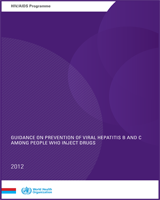It is estimated that 240 million people are chronically infected with HBV and 170 million are chronically infected with HCV (7-9). These numbers far exceed the number of people living with HIV, estimated at 34 million (10).
Co-infection with viral hepatitis and HIV is increasingly seen as a major public health problem: Chronic hepatitis B virus (HBV) infection affects 10% of people living with HIV worldwide, with great variability among geographical regions depending on the nature of the epidemic and other factors. Chronic hepatitis C virus (HCV) infection affects 20% of people living with HIV worldwide, with the majority living in low- and middle-income countries. Among PWID who are living with HIV, approximately 75% are co-infected with HCV (11,12).
The major modes of viral hepatitis transmission include unsterile medical injections, blood transfusions, sexual intercourse and injecting drug use (1, 13-16). HCV, however, is rarely transmitted sexually. In more recent years, as increased screening of blood products and the use of sterile equipment for medical injection has reduced transmission via these routes, injecting drug use has become proportionately more important as a vector for viral hepatitis transmission.
Both HBV and HCV can cause acute inflammatory hepatitis that can result in fulminant liver failure. Chronic infection can result in liver fibrosis and ultimately cirrhosis and hepatocellular carcinoma—conditions resulting in increased mortality (17,18). Both HBV and HCV can complicate HIV treatment, and HCV can accelerate the progression of HIV disease (19-26).
3.1. Viral hepatitis and injecting drug use
Injecting drug use is a major cause of morbidity and mortality worldwide. It is estimated that, globally, there are 16 million PWID (range: 11 million to 21.2 million), and injecting drug use is reported in at least 148 countries (1). HBV, HCV and related diseases are endemic among PWID (2). To date, however, the urgency of preventing HIV among PWID has overshadowed the epidemic of viral hepatitis.
3.1.1. Hepatitis B
In 2011 it was estimated that approximately 1.2 million PWID were living with chronic hepatitis B, as indicated by hepatitis B surface antigen (HBsAg), while nearly 6.4 million were positive for hepatitis B core antibody (HBcAb), indicating exposure to the virus (2).
The main mode of HBV transmission varies among countries depending on the endemicity of the virus. In highly endemic settings (e.g. much of Asia and Africa), perinatal and horizontal routes are responsible for most transmission, and 70–90% of the adult population has serologic evidence of prior infection. Countries with intermediate endemicity have a mix of perinatal, horizontal, sexual and health-care-related transmission. In countries with low endemicity, most new infections occur among young adults and are acquired sexually or through injecting drug use (27,28).
HBV infection is measured in two ways: as exposure to the virus (HBcAb) and as chronic infection (HBsAg). HBsAg prevalence data on chronic infection in PWID have been recorded in 59 countries, with 73% of the global PWID population. The prevalence of HBsAg in PWID correlates with the prevalence in the general population, with the highest prevalence in endemic areas of Asia () (2).
Epidemiology of HBV prevalence among PWID. Source: Nelson, 2011(2)
HBcAb prevalence data for exposure to HBV are available for 43 countries, with 65% of the global PWID population. Although the prevalence of HBcAb varies widely among countries, in general it is much higher than the prevalence of HBsAg (2).
3.1.2. Hepatitis C
It is estimated that, globally, 10 million PWID are infected with HCV, as indicated by the presence of the HCV antibody (HCVAb) (2). For PWID, sharing contaminated needles and syringes is the most common mode of HCV transmission. Sharing other equipment such as spoons and filters is also associated with HCV transmission (29,30). HCV is substantially more infectious than HIV, and many PWID are repeatedly exposed to HCV. This results not only in higher incidence rates but also in reinfection after clearance of HCV (31-33).
HCV is more difficult to transmit through unprotected sexual intercourse than is HIV (34-37). There is evidence that, among people who are co-infected with HIV and HCV, traumatic sexual practices or ulcerative STIs are conducive to sexual transmission of HCV (38-42).
Data on hepatitis C prevalence among PWID has been recorded in 77 countries and territories, which account for 82% of the global estimated population of PWID (2). The incidence of HCV among PWID is higher in low- and middle-income countries than in high-income countries (43). The largest populations of PWID live in China (HCV prevalence estimated at 67% of PWID), the Russian Federation (73%) and the United States (72%). On average, HCV prevalence among PWID is higher than 50% in most countries, between 60% and 80% in 25 countries, and above 80% in a further 12 countries (2). The prevalence of HCV among PWID is shown in .
Epidemiology of HCV prevalence among PWID. Source: Nelson, 2011(2)
Prevalence rates of HCV in prisons and other closed settings (like those of HIV and TB) are higher than in the community. In most countries PWID constitute a large proportion of the incarcerated population. Risk practices such as sharing injecting paraphernalia and non-sterile tattooing often occur in closed settings due to limited access to sterile equipment (44).
The epidemiology of HCV/HIV co-infection is less well understood. HIV/HCV co-infection is common among HIV-infected PWID—close to 100% in a number of countries (45-48). The epidemiology of co-infection generally follows that of HIV in PWID, with some exceptions (45-48).



